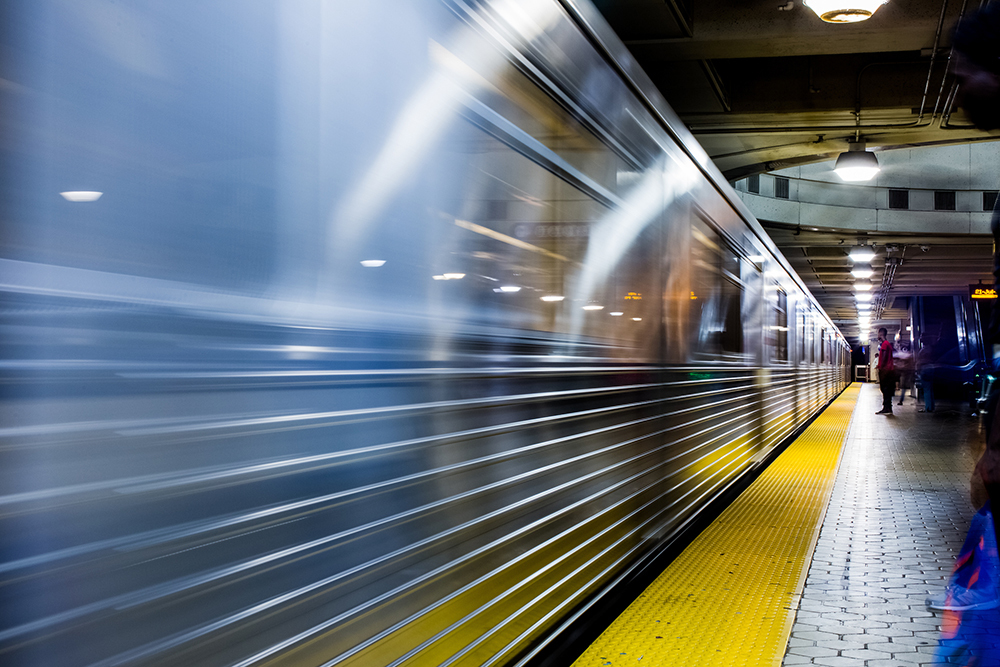
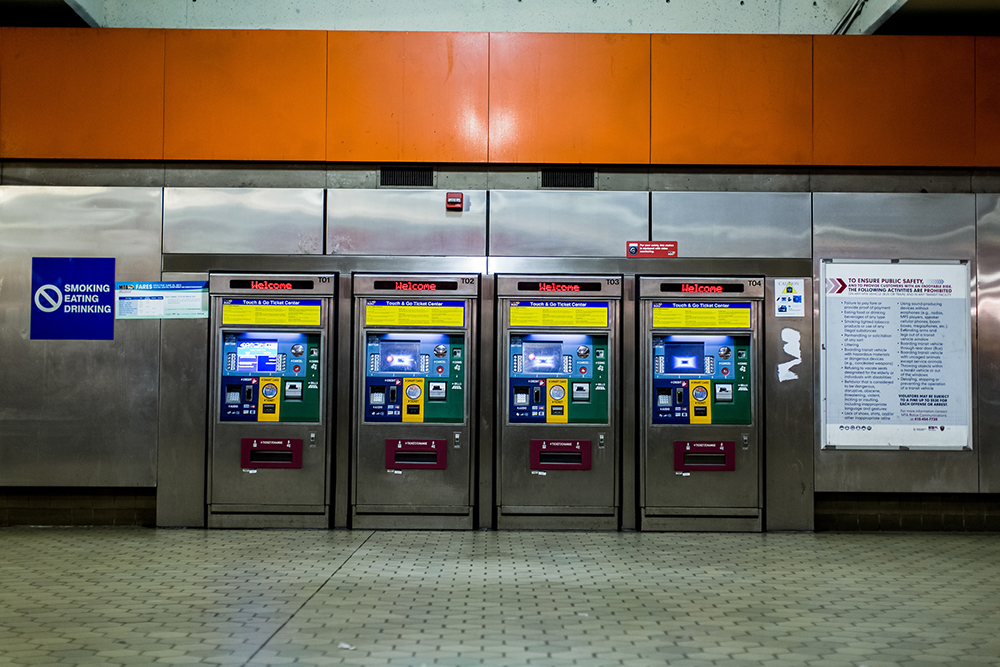
6:53 a.m. With the exception of the smooth jazz that plays over loudspeakers at all MTA stations, the Mondawmin platform is quiet. Even the escalator is quiet, since it is out of service. I scrawl “no rats so far” in my notebook.
6:59 a.m. I get onto my first train car of the day, headed outbound toward the terminus at Owings Mills. At each of the line’s 14 stations, an automated voice announces the current stop, the next stop, and the ultimate destination of the train, along with a description of any connecting buses.
7:01 a.m. One other announcement is sometimes added to the mix: A friendly warning that “for your safety and comfort, this vehicle is being monitored. Please be mindful of MTA’s prohibited acts.” This warning will be repeated roughly eight times per loop, meaning that I will hear it around 40 times today.
7:14 a.m. On reaching Owings Mills for what will be the first of six visits today, I switch cars, allowing me to face forward. This is a four-car train—the D.C. Metrorail system, in contrast, usually runs six- or eight-car trains. I would feel a sense of inferiority when comparing the two systems, but that would be pointless, like comparing the Nationals to the Bowie Baysox. For a minor-league transit system, the MTA does pretty well.
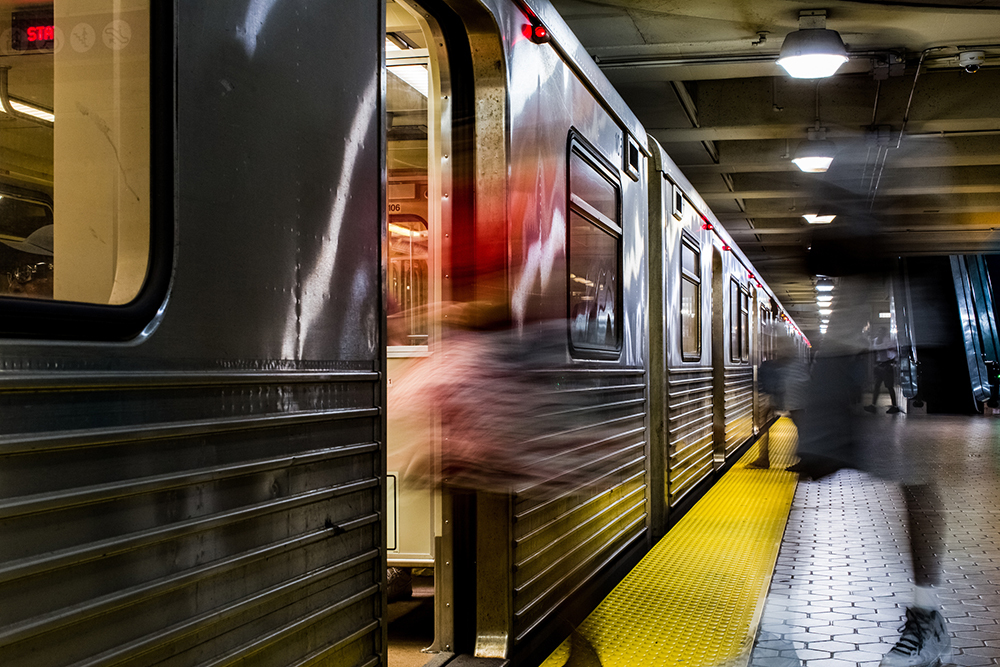
My previously nearly empty car—which is now inbound toward the city center and Johns Hopkins hospital—fills up with well-dressed commuters. The doors open and close four times in quick succession, and the train begins to move. The woman in front of me is telling her seatmate about an elderly relative. “She was able to walk, but she wasn’t able to clap.”
7:26 a.m. There’s still enough space in the train to allow a guy to chat across the aisle: “That place out on Reisterstown Road, they make the pineapple upside-down cakes, but only on Thursdays.”
7:29 a.m. They’ve moved on from cakes to cupcakes. “I don’t like how they let them just sit there sometimes.”
7:46 a.m. At Charles Center, the inbound train loses most of its passengers. That’s good because this is the most stuffed car I’ll be on all day, with standing passengers crowded in the aisles. As the automated voice reads off more than a dozen bus connections, I find myself wondering for the fourth time how many of those buses run on old streetcar routes.
***
A NOTE ON STREETCARS: Unlike Boston, New York and Philadelphia, Baltimoreans didn’t build a subway until near the end of the 20th century, preferring instead to rely exclusively on an extensive network of streetcars, and later, buses.
There was good reason for the city to be proud of its streetcar system. According to the book Baltimore’s Streetcars and Buses, the city was the home of the first electrified streetcars, starting in 1885. Some cars ran on elevated tracks, as with a line on Guilford Avenue. Others ran in traffic.
Early streetcars were as much of a real estate device as a transportation tool: Roland Park is often considered America’s first planned “streetcar suburb,” while other areas of the city were less planned but also dependent on streetcars, with “traction” magnates building lines to benefit their own land holdings.
In my neighborhood of Hampden, you can still see the ghosts of streetcar rails under some of the streets, including Falls Road and Chestnut Avenue. And, right nearby is the Baltimore Streetcar Museum if you want to ride on one of the relics.
***
8:17 a.m. On that subway, I notice that someone has brought along a Specialized Rockhopper, which is the mountain bike I lusted over as a kid. It is now covered in duct tape and looks fairly pathetic, but it’s still probably a good way to get around. I struggle to find a subway analogy there, but our metro car is spotless, fast-moving and in great condition. There’s no metaphor to be had.
8:41 a.m. People behind me are talking about the inscrutability of the Irish accent. “Those two people are clearly speaking a different language.”
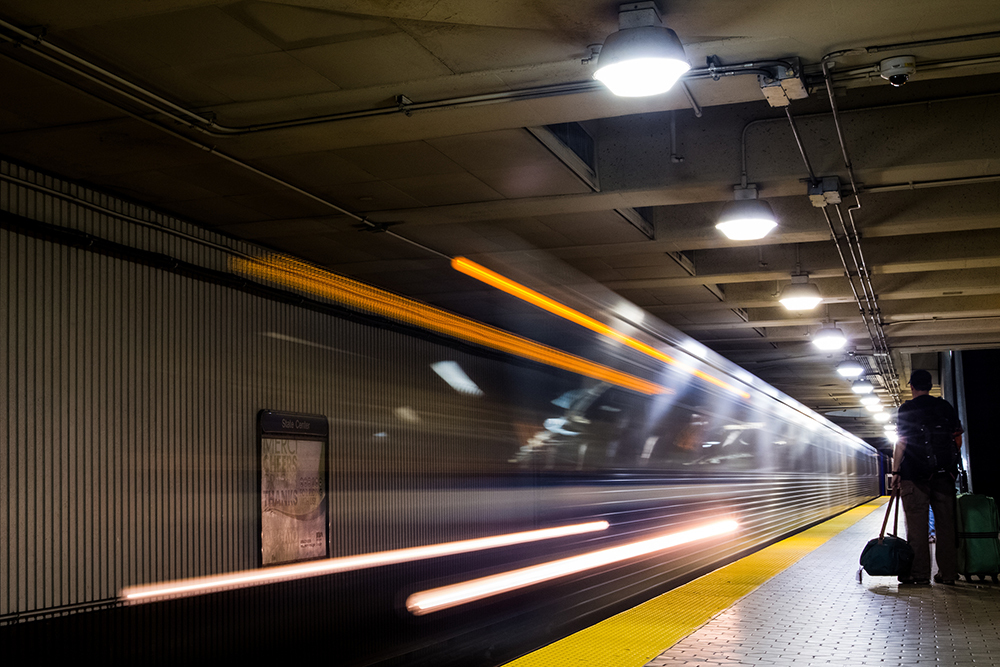
8:43 a.m. As if on cue, announcements have been replaced by a faint buzzing. I’m guessing that when I last switched cars, I got a dud. This is not entirely unpleasant, however.
9:01 a.m. A guy is rapping to his headphones. While this is common on MTA buses, it’s the first time I’ve seen it today. Other passengers roll their eyes.
9:15 a.m. I’ve been craving eggs since my second stop at Johns Hopkins, so I get off at the Lexington Market station. While the market has a reputation as one of the larger open-air drug markets in Baltimore, it also has a stall with one of the best breakfasts I’ve encountered. I buy the “super platter” of two eggs, three sausages, four pieces of toast, and a mess of potatoes, which costs me the grand sum of $2.12.
I take my breakfast up to the market’s balcony to eat, looking down over a bookstall. They have a special on paperbacks: “$8 – 3 for $10. We ship to prisons.”
10:46 a.m. Back on the train, I notice that the rail yard near the Rogers Avenue stop appears to have a lot of extra capacity. I wonder to what extent it was built for a larger system that never came to pass.
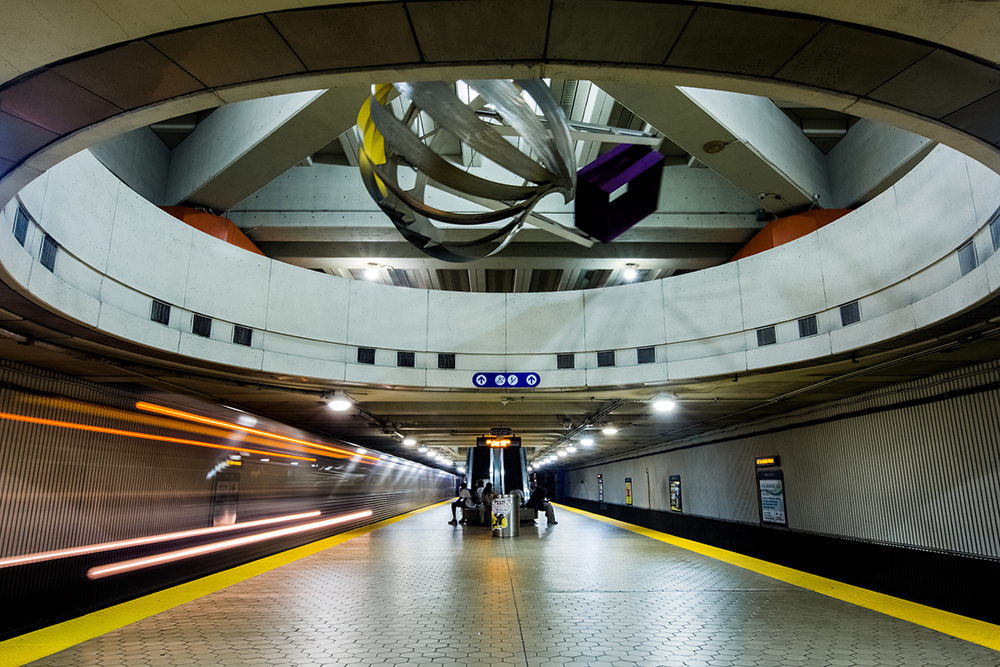
***
A NOTE ON PROGRESS: The rails on which I’m riding were not constructed without a fight.
Transit fans in Baltimore may already know most of the story. As time went on in the middle of the 20th century, Baltimore’s streetcars slowly fell victim to trends including badly maintained—and often intentionally neglected—infrastructure, alongside discriminatory state transportation policies that emphasized sprawl.
Baltimore’s single-route Metro system—conceived around the same time as the designs for the Washington, D.C. subway system—was originally supposed to fill that transit gap with several lines of heavy rail, extending outward from downtown to places like Morgan State University and the airport. Except that most of that system was never built as subway, which leaves the metro line on which I’m riding as Baltimore’s only underground intra-city transit line.
***
11:20 a.m. A heavy-set woman in front of me has a dragon tattoo that’s entrancing me as I sit in a food coma. It bobbles and ripples on her arm as the train changes speed and bounces minutely. She smells of cinnamon—is she a worker at the Fractured Prune donut shop in Owings Mills, where she got on?
11:25 a.m. She gets off at Lexington Market before I get the chance to ask her. Dammit. Now I want some donuts.
11:41 a.m. The car is half-empty and lacks conversations. I draw a cartoon of a rat pulling a train. It’s not very good: It looks more like a cat peeing on a series of tables. (I still haven’t seen any actual rats so far.)
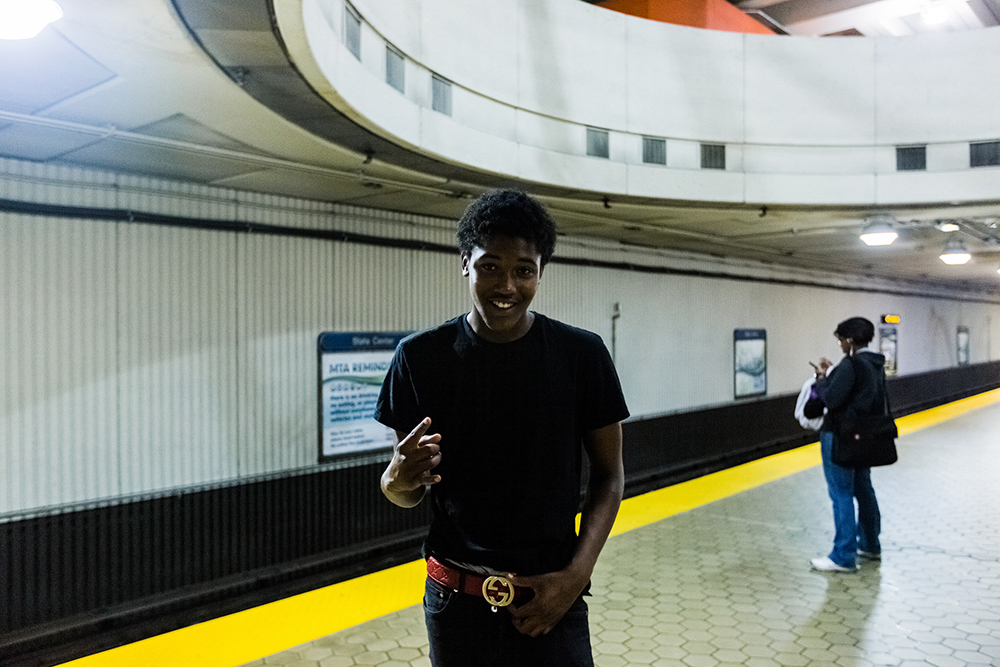
12:06 p.m. This donut craving is getting really strong.
12:13 p.m. The train is at Old Court. The robot announcer thinks it is at Mondawmin.
12:16 p.m. The train is at Milford Mill. The robot announcer thinks it is at State Center.
12:18 p.m. The train is at Reisterstown Plaza. The robot announcer thinks it is at Charles Center.
12:20 p.m. The train is at Rogers Avenue. The robot announcer thinks it is at Johns Hopkins.
12:39 p.m. After changing cars at the actual Johns Hopkins terminus, I find myself looking at a sign on the wall, telling me that a third of adults are pre-diabetic. I briefly doubt the wisdom of a donut-and-smoothie lunch.
1:11 p.m. Screw it. I want some fried sugar. I get off at Owings Mills and grab my donut fix. Owings Mills is quickly becoming my happy place.
***
A NOTE ON HAPPY PLACES: Despite the cancellation of the red line, there is indeed some good news on Baltimore’s transit scene.
The transit-oriented development at Owings Mills is one of these bright spots. After years of “coming soon” signs, a large, mixed-use development of apartments and shops is mostly open at the end of the line, complete with a branch of the county library system.
Further into town, there’s some indication that the long-stalled State Center project might be starting to move again. That project would add thousands of residential units and a bunch of retail to what is currently a Soviet-style office block of Brutalist architecture.
Finally, there are developments like the Maryland Avenue cycle track, the arrival of Zipcar in Baltimore, and the recent creation of protected cycling lanes on Roland Avenue. While these changes aren’t directly tied to the subway, they have the cumulative effect of nudging the city away from a car-dependent lifestyle, creating a ripple effect for transit.
***
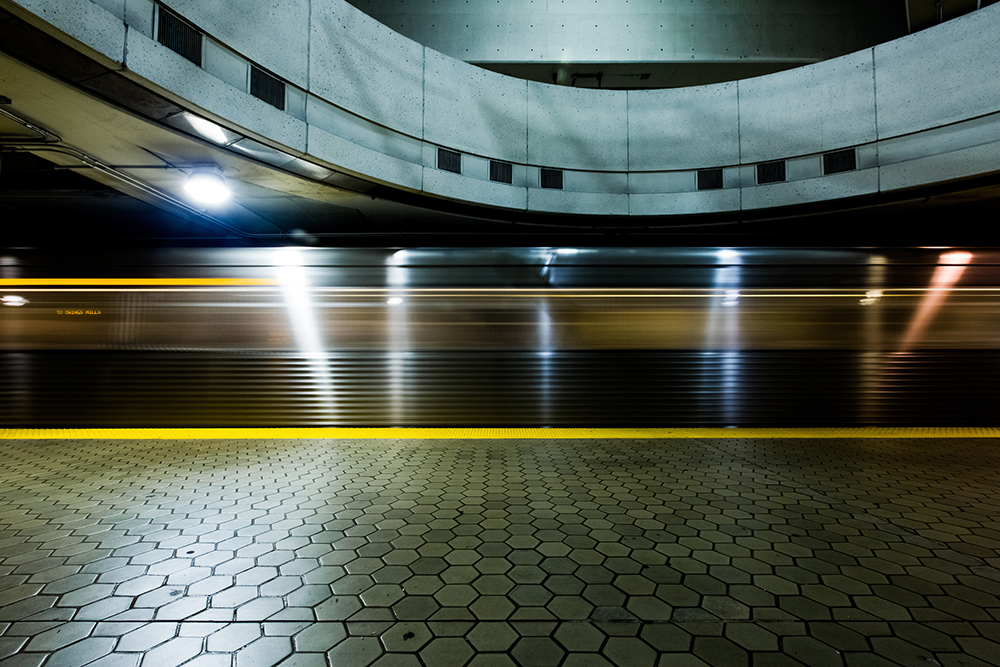
1:52 p.m. Back on the train, a woman is selling body wash and shampoo to passengers. “I had a full sack of these when I started,” she says. “You have to know how to carry yourself.”
2:07 p.m. As our train plunges below the earth near the West Cold Spring station, I find myself wishing Ben Folds had never written “Underground.” It’s been stuck in my head for most of the day—especially the line “hand me my nose ring.”
2:15 p.m. The shampoo lady has left. This train is utterly quiet, with the few remaining passengers abstaining from conversation.
2:25 p.m. I draw a cartoon of a rat shaped like a baby kangaroo holding a train car. It’s no better than my other cartoon. It looks like a tyrannosaurus with a wooden arm. I still haven’t seen any rodents of any size.
2:34 p.m. A man who got on at the Shot Tower station is now soliciting passengers quietly as they arrive from Lexington Market.
“Anybody need a job?”
“Anybody need a job?”
“Anybody need a job?”
He gets at least one taker.
2:34 p.m. We’re not at rush hour yet, but at the Upton Avenue stop, this train is starting to fill up again, with some passengers standing in the aisles.
3:00 p.m. At the Owings Mills terminus for the sixth time, I switch from an out-of-service, four-car train to a newly formed six-car train. They’re clearly getting ready for rush hour.
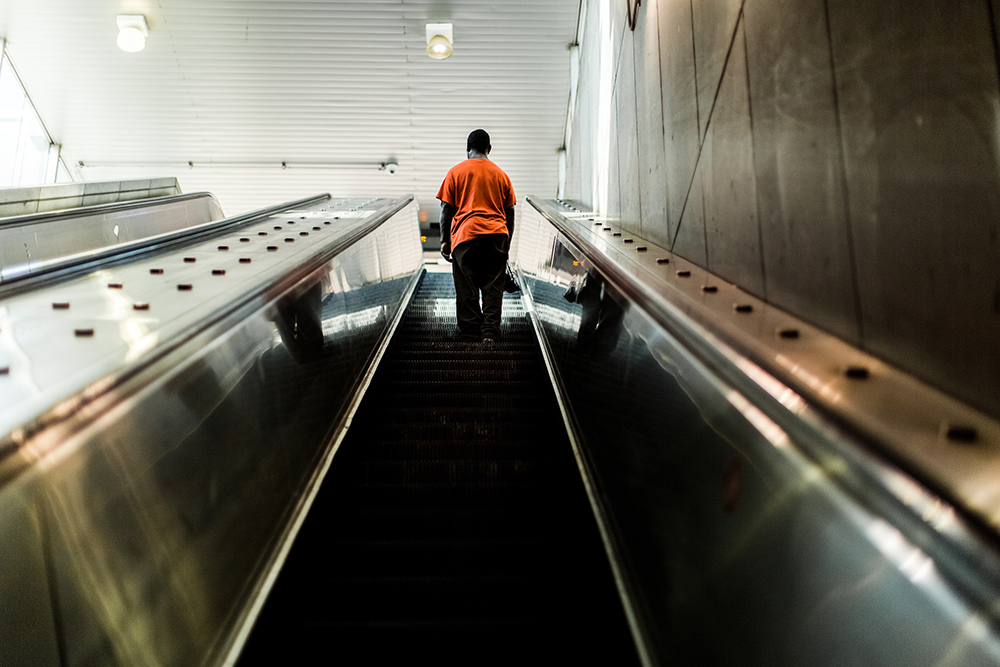
3:25 p.m. I arrive at Mondawmin. I have taken five loops around the system, listened to dozens of surveillance announcements, heard hundreds of intersecting bus-line numbers, and consumed more than a thousand calories.
Putting aside some misplaced directional announcements, the trains seem to have functioned pretty well during my marathon of user testing. They have been clean and fast. No doors have opened randomly mid-trip. No kangaroo-sized rats have made appearances. Nobody has evangelized me, nobody has gotten sick near me. In other words, this has been the equivalent of a pleasant homeward commute—just longer. A lot longer.
But the time of day and the extra calories are having their effect. I shake myself from my afternoon stupor, get off the train and begin waddling home, happier than ever to be on foot.
